Summary of the lesson on familiarization with the outside world "Autumn changes in nature
State special (correctional) educational institution for pupils with disabilities, secondary school - boarding schoolViii view from Vannovsky Krasnodar Territory
Speech Development Lesson Summary
in 4th grade
“Seasonal changes in nature. Signs of autumn. "
has prepared
primary school teacher
Maslova Galina Aleksandrovna
with. Vannov
2011
Speech development
TOPIC: Seasonal changes in nature. Signs of autumn.OBJECTIVE: 1. To learn to observe nature and draw conclusions about changes in inanimate and wildlife with the arrival of autumn; repeat signs autumn months, autumn. 2. Develop speech, memory, attention, observation, ability analyze. broaden your horizons; 3. Foster love and respect for nature, animals, to birds.EQUIPMENT: Reproductions with the image of autumn landscapes, a bouquet of autumn leaves, subject pictures with the image of animals, birds; individual cards, poster “Structure of the sheet”, presentation.During the classes.
I . Organizing time.
a) Delivery of the report on duty class.
b) Evaluation by the teacher of preparing the class for the lesson.
II . Introductory conversation.
1. Work with pictures . Slide 2-4
Look at the pictures, what time of year is depicted?
Name the autumn months.
Name the signs of autumn.
(As a result of the discussion, major changes in nature are highlighted.)Slide 5
* In short light day.
* Sun below horizon.
* Cooling.
* Frequent rain and fog.
* Changes in the plant world.
* Changes in the animal world.
2. Work with the weather calendar.
Tell me how the weather has changed in October compared to September.
What days have become more sunny or cloudy?
What can be concluded?
What is the weather today? (The attendant notes the weather in the calendar.)
3. Reading a poem by a teacher. Slide 6
Despite the fact that it has become colder, autumn is a great time of the year.
In your tent, magical
And beautiful.
Autumn called us to the feast,
Everywhere scattered their colors,
And nature has miraculously blossomed!
4. Reading a poem learning.
Autumn on the edge
Paint bred,
By the foliage quietly
Brush held.
Yellow hazel,
Maple trees,
In autumn purpura
Only oak green.
Birds fly away
Do not regret the summer!
Look - grove
Golden color!
III . Announcement of the topic of the lesson. Slide 7.
IV . Fastening study material.
1. Work on the story “The forest holds the exam” by N. Nadezhdina.
a) Selective reading.
Read what begins in the forest in autumn? (Vacation.)
What must forest dwellers do before autumn dismisses them for the holidays?
(Must pass the exam.)
Read who passed the exam first? (Migratory birds.)
b) Guess the riddles.
Flies to us with warmth,
Make a long way.
Sculpts a house under the window
From grass and clay. (Swallow.)Slide 8.
All day I catch beetles
I eat bugs, worms.
I don't fly away in winter
I live under the eaves. (Sparrow.)Slide 9.
(Pictures with the image of a swallow and a sparrow are posted on the board.)
What is the difference between these birds?
(Swallow - migratory, wintering sparrow.)
2) Work on the proverb. Slide 10.
Explain the meaning of the proverb.
"September hurries birds on the road."
No matter how good the autumn weather is, no matter how satisfying the September forest is, and some birds must fly away - the path is not long.
What is the reason for the autumn departure of birds to warm countries?
(With a lack of feed in cold, winter time.)
3. Guess the crossword. Slide 11.
| c | but | p | l | i | |||||
| d | i | t | e | l | |||||
| g | r | but | h | ||||||
| at | about | r | about | b | e | th | |||
| well | at | r | but | at | l | and | |||
| e | |||||||||
| l | but | with | t | about | h | to | but |
||
| f | and | l | and | n | |||||
| s | |||||||||
| with | to | at | about | r | e | c |
1. On one leg,
In the water gazing.
Looking for a river frog,
A drop hung on the nose
You will find out(heron).
2. He has a long tree hollow
And all the bugs exterminated.
In vain did not waste time
Of course it is(woodpecker).
3. All migratory birds are black.
Cleans arable land from worms.(Rook).
4. The little boy
In the gray armouver,
Darts around the yard
Crumbs are collected.(Sparrow).
5. Became brothers on stilts,
Looking for feed along the way.
Whether on the run, on the go -
They do not get off with stilts.(Cranes).
6. guess what a birdie:
Dark little girl,
White with a belly
The tail forked, in two tails.(Swallow).
7. During the day he sits like a blind man
And only the evening - for robbery.(Owl).
8. On the pole is the palace
In the palace is a singer,
And his name is -(starling).
4) Conversation;
Which of the listed birds are migratory, and which are wintering?
Tell me, what birds are left to spend the winter in the Krasnodar Territory?
What should be done to make it easier for birds to spend the winter?
Well done.Slide 12.
4) The story of the teacher.
The Orioles, Swifts, Swallows, Nightingales are the first to leave our forests. Just before the onset of cold weather, geese, ducks, and cranes fly away.
Have you seen the birds fly? Tell us about your observations.
(Stories of children).
Cranes and geese fly "wedge" (angle).Slide 13-15.
The bird flying ahead is the hardest. She cuts the air. Adults, the strongest birds always fly ahead, and behind them are young and weak.
Fiz. just a minute
Zhuravel, Zhuravel!
He flew over a hundred lands.
Circled, bypassed,
Wings, legs strained.
6) Work on the story.
How do the trees pass the exam? Read.
a) Selective reading.
(The leaf fall begins).Slide 16.
b) Teacher's story. (On the tables of the children are autumn leaves).
In autumn, the leaves begin to turn yellow. Yellow paint is always in the leaves. Only in summer is yellow color invisible. It is drowned out by a stronger green one.
Autumn is coming, the nights are lengthening, the plants get less light. The green color in the leaf decreases, and the yellow color becomes more noticeable. But the leaves come in different colors. It depends on what coloring matter is in the fading sheet.
Pick up autumn leaves, tell a poem and make a bouquet.
7) Reading a poem learning.
Golden leaves fall, fly.
Golden leaves carpeted garden.
A lot on the paths of gold leaves,
We will collect a nice bunch of them.
We will put a bouquet in the middle of the table,
Golden autumn came to us.
8) Conversation.
What is leaf fall for?
(Children's answers).
Conclusion: Slad 16.
* Tree protection from winter drought.
* Disposal of wood from toxic substances.
* Protection of thin and fragile branches from the severity of snow falling in winter.
9) Practical work.
What is the difference between the leaves?
(Form, size, color).
What does it depend on?
(From which tree the leaf is taken.)
Is there anything in common in each sheet?
(Sheet plate, veins, petiole.)
10. Independent work.
a) Children sketched the structure of the sheet on the album sheet.
b) A poster appears on the screen: "The structure of the sheet."Slide17
Fiz. just a minute
The sun is paler,
The sky is colder.
If you go out in the evening,
Jackdaws get cold in the wind.
Long shadow falls
Long leaf falls.
11. Selective reading.
Who else is holding the exam in the fall? (Beasts).
Autumn is busy time for animals, they are preparing to winter
And here is the squirrel, and bunny,Slide 18
prickly hedgehog, brown bear.
Now we ask them to say
How they all meet autumn.
12. Dramatization: "Autumn meeting in the forest."
Hare: It's time for me to play
It's time for me, change the coat.
I can't be gray in winter
I will be noticed in the snow.
Squirrel. And I hurry, hurry,
I'm on the knots of dry land mushrooms.
In the winter I make a stock
I am very cold now.
Bear. In the den I will soon go to bed,
Over the fall - winter again.
Let me in a dream
Dream honey.
Wake up when spring
Will come.
Hedgehog. I am going to sleep too,
Like a teddy bear.
I was horny over the summer
Looking for mushrooms, catching mice,
I need to rest for it.
I'm tired, exhausted.
I will bring knots to myself
I will make an apartment in the forest.
Teacher Well then, try,
In good time.
We are in the spring, we will be glad to see you again.
13. The repetition of the rules of human behavior in the forest.
Do you know the rules of human behavior in the forest?
(Stories of children).
V . Reiteration. Slide 19.
a) Reading the rules.
* Protect plants and animals.
* Do not burn the grass in the fall, as the forest can catch fire from it.
* Do not chop or break trees and shrubs.
* Do not leave jars and bottles in the forest. Take it with you and discard it in a specially equipped place.
* Do not ruin nests and anthills.
* Do not make noise or disturb the inhabitants of the forest.
b) Work on a crossword puzzle
Every season has its favorite color, what color of autumn, we will find out by solving a crossword puzzle.
1. What is the name birds that stay to winter? (Wintering.)Slide 20.
2. The phenomenon of nature, often in the fall. In the summer it is called warm, mushroom, in the fall - cold, drizzling. (Rain.)
3. The phenomenon occurs only in the fall. Trees dress up in beautiful hats, and then shed their leaves. (Falling leaves.)
4. If the night is colder than the day, water droplets form on the grass, what is it? (Dew.)
5. This phenomenon of nature is like a light haze in the air, and sometimes a white transparent wall. What is it? (Fog.)
6. The time of year following the fall. (Winter.)
7. In autumn, birds fly to warm lands. They gather in large groups.
What is the name of such a group? (Pack.)
| s | and | m | at | yu | u | and | e | |||
| d | about | well | d | s | ||||||
| l | and | with | t | about | p | but | d |
|||
| r | about | with | but | |||||||
| t | at | m | but | n |
||||||
| s | and | m | but | |||||||
| with | t | but | i | |||||||
VI . Total. Slide 21-22.
Evaluation of the work of children. Presentation of autumn leaves with the assessment.
The forest holds the exam.
In the forest in the fall holidays begin. The plants have ripened seeds, birds and animals raised their young, you can relax.
But before autumn dismisses forest dwellers for the holidays, they must pass the exam. Without exception: the little grass, and the big tree, and the bird, and the beast.
Ask for exams will be frost, and with all severity. Each is asked only one question - the question of life. Who fails the exam, he will not live until next spring. The first, in the summer, passed the exam migratory birds. They needed to be molded, to change the feathers on the wings: after all, to fly - it would have to be far away.
You walk through the autumn forest, and autumn leaves are spinning above your head. Drop at your feet.
Yellow leaves - a signal of drought. The roots take water from the ground and feed it to the tree, the leaves consume it and evaporate it. If the water flow is greater than the arrival, in order not to die from drought, the tree must part with the foliage.
But it was raining three days ago, and it was drizzling yesterday. Can there really be a drought in September? Is there really not enough water for the tree? There is a lot of water, but it cannot take a tree. The earth has become cold in autumn, and the root hairs do not suck in cold water. It's time for the trees to take the exam. Leaf fall has begun.
Lift the yellow sheet from the ground, try a finger, how thick and rough the petiole has become.
Thousands of leaves lose a tree in the fall, but there is not a single wound in the tree from which the sap would leak.
The leaves will fly, but buds will remain on the branches. They will turn green next spring.
Preparing for exams and animals. Bear - like a bear: to get to the berries of mountain ash, he bends and breaks the whole tree. The bear goes on feeding and in the field, until there is squeezed oats. For a bear, a hedgehog, a badger, to pass an exam is to put on fat. To count on food in winter beasts do not have to. Only fat they will be alive. It is necessary to accumulate more fat: a skinny will not make it to spring.
The less a beast moves, the less it will consume fat. The bear falls on the side. Their holidays bear, hedgehog and badger oversleep.
No wonder the badger arranges in his hole a featherbed of dry leaves. Half a year to lie on the hard - the sides are sick.
N. Nadezhdina
List of used literature.
Khudenko E. D., Terekhova I. A. Acquaintance with the world around. Textbook for special (correctional) schoolsViii kind of. 4th grade. Moscow 2004
Aksenov A.K., Yakubovskaya E.V. Didactic games at the lessons of the Russian language in grades 1-4 of the auxiliary school.
Kostina E. P., Morozova S. A., Azaryan D. A. Speech development in elementary school students. Teaching manual. Krasnodar 2001
Yudina I. G. Natural science. Non-standard lessons and creative tasks. 1-4 class. Volgograd 2002
Department of Education and Science
administration of Gubkinsky urban district
municipal budget educational institution
"Secondary school number 7"
Methodical development of training classes.
Gubkin - 2013
Seasonal changes in nature. Autumn.
Explanatory note.
Methodical development is a cycle of three classes under one title: "Seasonal changes in nature." Tours are held at different times of the year - in the fall, winter and spring. The first tour of this cycle is held in the fall. Of course, it is difficult to disagree with what is best understood and imagined how nature can change only in the process of personal observations. It is very important to show and tell children that autumn is a long period of time when nature is preparing for winter. After all, autumn is that period of preparation for cold weather, lack of food, and winter precipitation in the form of snow. Different animals behave differently at this time. Excursion should be carried out in the nearest park, square. Children are often there. Many of them know which trees grow there. In the process, they can be active assistants for the teacher. It is important that after the excursion the children understand that everything in nature is natural. The leaves change color because there is not enough sunlight. They fall so that in winter the branches do not break under the weight of snow. Migratory birds leave our region, as they will not be able to feed themselves in winter and freeze, unable to withstand low temperatures. That all animals adapt to life by their rules and laws.
Purpose of the tour : observation of autumnal changes in animate and inanimate nature.
Tasks:
- observe autumnal changes in wildlife;
- to acquaint children with coniferous and deciduous trees, the peculiarity of their preparation for winter, to learn to recognize the leaves of the most common tree species;
- to cultivate a sense of beauty, the ability to admire the beauty of the world, respect for nature.
Used methods:
- verbal: the story of the teacher, guide and statements of students, a short conversation;
- observation;
- practical: drawing up herbariums from autumn leaves.
Age of students: 7-8 years.
Equipment and design:
- herbarium folders;
- empty cardboard boxes for dry leaves;
- two red flags to accompany the column of children when passing through the roadway.
Methodical tips for the preparatory period:
Preparing the teacher for the tour.
Before you organize a tour, the teacher must choose a suitable place for it. It is advisable to choose a plot of the park, a square with deciduous and coniferous trees. Having visited the venue of the excursion the teacher outlines objects for observation, places for stops.
It is necessary to pre-divide the children into three groups. One advisor should be appointed in each group. Consultants are issued a package in which there is a folder for herbaria.
Preparation of students for excursions.
In previous classes, children repeat the rules of behavior in the forest, park, square. Immediately before the excursion, the teacher reminds the children about the rules of crossing the road.
Excursion plan:
- Introductory conversation.
- Familiar with deciduous trees.
- Collection of autumn leaves for herbaria.
- Familiar with coniferous trees.
- Bird watching.
- Talk about animals of the park.
- Summing up the excursion.
1. Introductory conversation.
(Held directly at the site of the tour.)
Teacher: What time of the year is it?(Autumn.)
Pay attention to the sky. What is it?(Children's answers.)
How does the sun warm?(Children's answers.)
How has the length of the day changed? (Children's answers.)
Guys, you already guessed where we are. Guess the riddle:
The guys have a green friend,
Cheerful friend, good
He will give us hundreds of hands
And thousands of palms.
- You guessed it, what kind of green friend is told in a riddle?(Forest, park.)
What palms are they talking about here?(Leaves.)
Has the appearance of leaves changed compared to summer?(Children's answers.)
2. Familiar with deciduous trees.
Teacher: I suggest you collect different leaves under the trees.
(Children collect leaves, the teacher reminds that the leaves should be collected, not picked from the trees, so as not to accidentally break a branch and not to cut the tree).
Teacher: Trees that have leaves growing on the branches are called deciduous.
Which deciduous trees are familiar to you?(Poplar, birch, maple, linden, chestnut, pear, apple, rowan.)
- Tell me, how are your leaves different from each other?(Size, color, shape.)
(Kids review the leaves)
Teacher: Is it possible to determine from which trees these leaves?(Yes you can.)
Here this leaflet has one leaf plate and one cutting.(The teacher shows a sheet of maple, linden.) Such leaves are called simple.
This leaf has several leaf plates and one cutting.(The educator shows a chestnut leaf, a rowan.) Such leaves are called complex.
What happens to the leaves in the fall?(They fall off.)
Do you guys know why fall trees shed their leaves?(Children's answers.)
Snow often falls in winter. If there are a lot of leaves on the trees, the snow will stick to them, the branches under the weight of snow will bend to the ground, may break, the tree will die. So nature took care of the trees.
3. Collection of autumn leaves for herbaria.
- I suggest everyone to disperse in groups and decompose the leaves in herbarium folders with respect to wood species. First choose the well-known leaves.
(At the end of the work, the children take turns calling the trees to which the picked leaves belong.)
4. Familiar with coniferous trees.
Teacher: Winter and summer one color.
What tree are we talking about?(Spruce.)
- Small needles on the branches - needles. Therefore, trees are called conifers. Coniferous trees also drop needles, but not all at once, but little by little throughout the year. And the needles also grow all year round.
What other conifers do you know?(Pine.)
(The teacher shows a sprig of pine and spruce).
- See what they look like and how they differ.(Pine needles are longer, spruce ones are shorter. Pine needles cling to a twig by two, and from spruce one by one.)
- And the branches of coniferous trees are flexible, they easily bend to the ground under the weight of snow, they do not break. And on the top there are always a lot of bumps.
5. Bird watching.
Teacher: Look at the flock of sparrows. It's getting cool. Oh, not so funny birdsies. And winter is coming. The snow will cover the earth with a thick veil. What will the birds eat? (Children's answers.)
And what will happen to those birds that feed on insects, foliage, grass?
(They flew off to warm lands.)
And what birds are left to winter? (Children's answers.)
- And so that the birds do not live in misery in the winter, let's make feeders for them.
6. Talk about animals of the park.
What do you think, what animals are found in our park?(Mice, hedgehogs.)
How will they meet the winter?(Mice will harvest grain and seeds from plants to storerooms, spend the winter in a warm mink, occasionally going out for a walk. The hedgehogs will tug at the herbs, roll around in the dry leaves and sleep for the whole winter in the hole.)
7. Summing up the tour.
What have you learned in today's lesson?
What did you like most?
And now I propose to collect bouquets of autumn leaves for moms. The tour is over.
Methodical advice to the organizers:
Organization of excursions - the nearest park, square. It is advisable to choose a place where many different trees grow. You can show children such trees as linden, maple, chestnut, poplar, pear, apple, mountain ash.
Show leaves, tree trunks.
In the herbarium folders put the leaves of these trees as samples.
Methodical tips for the period of the next aftereffect:
In subsequent classes, children make out herbariums. You can offer to participate in the drawing contest "Golden Autumn". Children make bird feeders and hang them in the yard of the station, kindergarten, school.
Bibliography
- Nuzhdina T. D. Encyclopedia for Kids: A miracle is everywhere. The world of people. / Yaroslavl: Academy, K; Academy Holding, 2000.
- Pleshakov A.A. The world around us: Method. Benefit: 1 class. / A.A. Pleshakov, V.P. Alexandrova, S.A. Borisov. - M .: Education, 2002.
- Fefilova E.P., Potorochina E.A. Pourochnye development at the rate of the world. WAKO - Moscow 2006.
Has prepared: Gapchenko Svetlana Nikolaevna, social teacher
municipal budgetary educational institution "Secondary school № 7" of the city of Gubkin, Belgorod region.
Integrated world and technology lesson
for students in grade 4 with ch. y about. under the program of correctional schoolsViii kind of.
Theme: “Seasonal changes in nature. Autumn".
Purpose:summarize and systematize children's ideas about the characteristic signs of autumn.
Tasks: a) educational: to organize the activity of students in perception, comprehension and memorization of knowledge about seasonal changes in nature in the autumn; to form an idea of how nature prepares for winter; to make an application "Leaf Fall in the Autumn Forest".
b) developing:develop the ability to observe, compare, analyze, summarize; develop cognitive interest in the world; develop fine motor skills.
c) educators:respect for nature
Equipment:
- presentation on the theme "Autumn";
- color paper, scissors, glue;
- textbook E.D. Khudenko, I.A. Terekhova "Acquaintance with the world around."
During the classes.
- Organizing time.
- Introduction to the topic.
Empty in the field, it is raining.
The breeze tears off the leaves.
From the north the fog creeps,
Clouds of menacing looming.
Birds move south
Slightly wing touching the pines.
Guess, dear friend,
What is the time of year? (Autumn)
How did you guess that the poem about autumn? (children's answers)
If they find it difficult: empty in the field, the wind tears the leaves from the trees, the birds fly south, rain pours when it happens? (autumn).
Who guessed what topic of the lesson? (AUTUMN).
- Work on the lesson.
Right guys. Theme of the lesson: “Autumn”. In the lesson we learn to answer with a full answer, to make sentences correctly, clearly pronouncing the sounds in words.
Look at the hint picture. Let's remember what happens in the fall in nature? And tell you what signs of autumn we know.
Encourage children to respond with complete answers. (The days are shorter, the leaves have turned yellow, the water in the river is cold, the harvest time, the birds fly away, the animals hibernate, it has become colder, it often rains cold).
Well done, you know the signs of autumn.
Remember and name the autumn months. (children's answers)
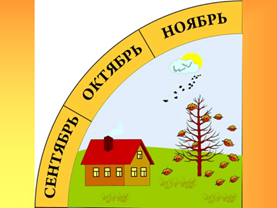
Autumn is very beautiful to watch the trees, as foliage changes its color.
- Fizminutka.
Yellow leaves fly, fall, spin,
And just under the feet like a carpet go!
What kind of yellow snow? It is just ....... (leaf fall).
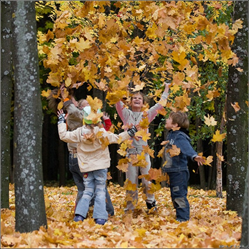
What time is it called when the leaves fall and fall under our feet? (Falling leaves).
V. Work with the textbook.
Task number 1.
Find a drawing depicting the “golden autumn”.
Why did you choose this picture?
What emotions does this autumn cause you?
Describe leaf fall using 10 action words.
Vi. Practical work.
Today in the class we will perform the application “Falling Leaves in the Autumn Forest”
You have colored paper and cardboard on the table.
What colors are leaves in autumn? (Examining pictures with autumn nature)
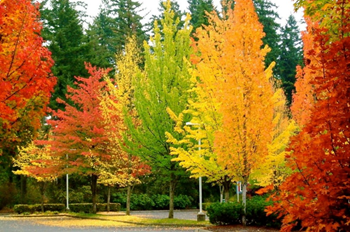
Choose paper colors that are suitable for leaves.
First we have to cut the trunks of the trees for our forest. (The outline of the trees is already drawn on brown paper)
Carefully working with scissors. (help cut if necessary)
The trunks of the trees are ready. Now we will do leaf fall.
The leaves can be done in two ways: 1. If the children have a good scissors, cut into small pieces of paper of different colors
1. If children do not know how to use scissors - tear paper into small pieces.
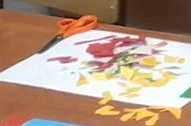
The trees are ready, the leaves too, now we glue the tables onto the cardboard-background of the appliqué. And glue the leaves.
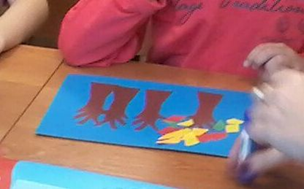

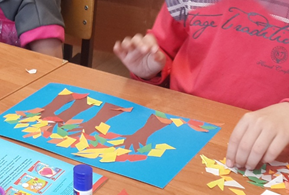
Our "leaf fall in the forest" is ready! Look at what beautiful work you did!
VII. Fastening.
- And what time of the year is your forest?
Ball game.
- I throw the ball and ask the question, and you answer and throw the ball back.
Questions:
What color is the sky in the fall?
What is the weather like in the fall?
What is the sun in the fall?
What air in the fall?
What is the mood of autumn?
Name the autumn month.
Viii. Reflection.
What did you learn in class?
Who liked to do the appliqué?
Who today was in a good mood in the classroom?
Nina Dyrnaeva
Summary of the game-excursion “Seasonal changes in nature. Looking for autumn "
Summary of excursions - games on a subject
« Seasonal changes in nature. Looking for autumn».
Goals: To acquaint children with the phenomena of animate and inanimate of natureinherent the fall, learn to detect relationships between phenomena of nature.
Develop observation, the ability to analyze.
Nurture love to to nature, understanding of her beauty, caring attitude to her.
The development of the speech of children.
Vocabulary: Maple Rowan Lion Rover
Equipment: rope, signs, picture.
During the classes:
1. Organizational moment.
2. Introductory conversation.
What time of the year is it?
-Autumn.
Where is she? Have you seen her?
No, it's still warm ...
But autumn has come. What month is it?
September.
it autumn month?
But autumn has come. Where is she? Maybe she hid? Let's go look for where to hide autumn.
Search will be on the picture « Autumn» . You know the signs the fall? Let's make her portrait together.
The teacher shows pictures of birch. It is still with a green crown, in which several yellow leaves are visible.
Name signs autumn on a birch.
Yellow leaves.
Right! So let's go look for this attribute autumn.
Teacher offers children "Go" in an all-terrain vehicle called Yellow Leaf.
And where do we get the all-terrain vehicle?
Yes, here he is!
The teacher pulls out a soft rope, the size corresponding to the number of children in the class, standing next to each other. Children take the rope in the hands of the right and left.
All-terrain vehicle is ready to move!
The movement of children is organized on the route chosen by the teacher. This is a forest.
3. First stop - at the birch.
Admire the birch, look at it carefully and try to find signs on it the fall. Who remembers what the main feature the fall?
Yellow leaves.
Well done! Solved the riddle the fall. Found where she is hiding. Think again and tell what color autumn?
-Autumn is yellow ...
And now look for another sign of autumn. We will search on the ground. See what it is?
These are fallen leaves.
What leaves lie under a birch tree?
Right.
The teacher suggests comparing two birch trees by the number of yellow leaves on the crown. It is further proposed to collect fallen leaves for the manufacture of applications.
4. The second stop - at the mountain ash and maple.
What color leaves have mountain ash?
Red
Pay attention to the fruits of rowan.
What color are maple leaves?
And what are the fruits?
That's right, maple fruits - lionfish. Compare the leaves of maple and rowan. They are the same?
No, they are different.
Maple leaves and rowan differ in color and shape. Collect the leaves for application.
You and I got into a fairyland called Les. These trees are familiar to you from childhood. Together with them we fall into a fairy tale. In the forest one can believe that it is here that Baba Yaga, Leshy and other fairy-tale heroes live. But some bad people cut down trees, break them. Can I do this?
And who knows how to behave in the forest?
Children talk about the rules of behavior in the forest.
The forest is our wealth. It must be protected, protected from bad people, from fire. In the forest we come to rest, pick mushrooms and berries. And may it always remain as green, beautiful, clean as it is now.
Summing up the tour.
What interesting things did you see in the forest today?
Children talk about their impressions.
The tour ends, the children go to the shelter with the tutor.

